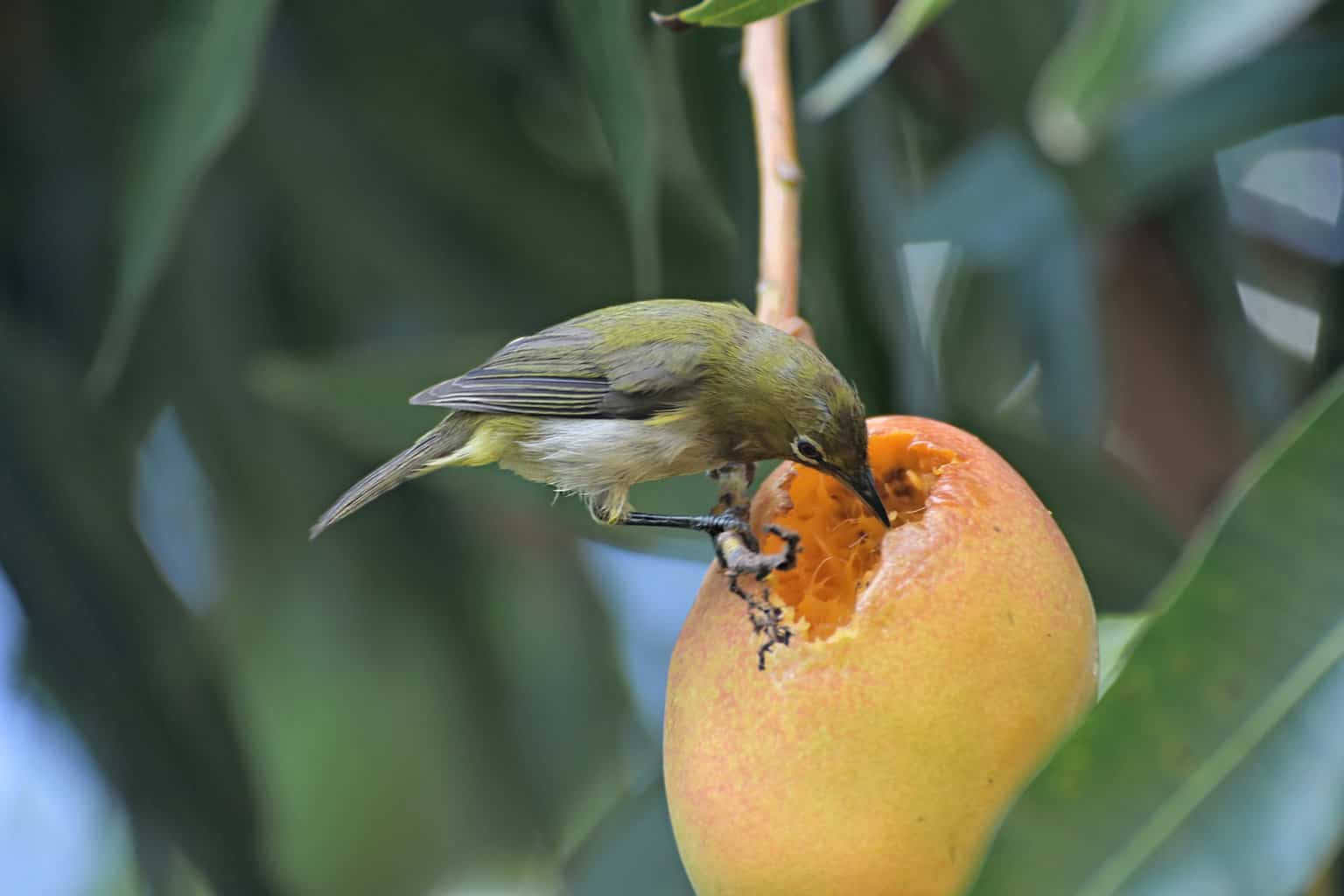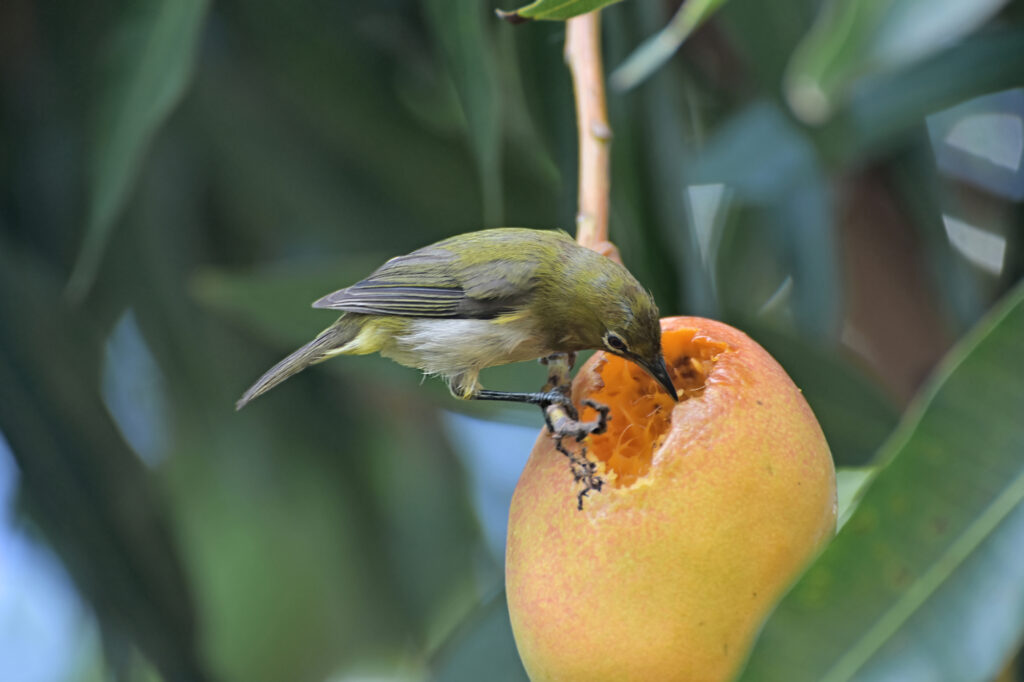Mangoes are popular with humans for their nutritional content and delicious, sweet taste. But do birds like them? Do birds eat this tropical fruit, and is it good for them to do so? Should you feed mango to the birds in your garden or your pet birds? And if so, how should you do so?
Many birds do eat mango, and this fruit can be a delicious treat for backyard birds or pet species. But there are a few other things you need to know, so read on to find out more and ensure you do the right thing when feeding the birds in question.
Do Birds Eat Mango?
Birds do indeed eat mango in the wild, where these trees naturally grow, and in gardens. Many birds will also often eat mango when it is offered at a bird table or another feeding station.
The mango is the fruit of the tropical tree Mangifera indica. This tree is native to parts of East Asia but is commonly cultivated in many tropical or subtropical areas and even some very warm temperate regions around the world.
Mango trees can typically be grown in USDA hardiness zones 9b and above in the United States and most easily in zones 10 (southwestern California and southern Florida, some of Hawaii) and 11 (some of Hawaii).
Since this is not a native tree in the United States, the mango is not a natural food source for most garden birds in this region. But that will not stop many birds from opportunistically taking advantage of mangos as a food source when they are available.
Which Birds Eat Mango?
Many fruit-eating birds will eat mango if it is provided in a garden. Fruit-eating birds include bluebirds, jays, mockingbirds, orioles, robins, tanagers, thrashers, and woodpeckers.
Seed-eating birds will also enjoy eating fruit on occasion. And there are also omnivorous birds like crows that will eat pretty much whatever is offered.
Some birds will take chunks of the flesh, while others may sip at the mango juice or take a tiny bit.
Parrots and many other exotic birds kept in captivity are also said to enjoy eating bits of mango as a treat.
Is Mango Beneficial for Birds?
Mangos are high in polyphenols, which act as antioxidants. These fruits are also high in folate, vitamin A, C, B, E, and K, which boost the immune system.
Mangos also have large amounts of water, dietary fiber, enzymes that aid digestion, and natural fruit sugars.
Many of the things that make mangos suitable for people also bring health benefits to birds.
Is Mango Safe for Garden Birds?

The good news is that it is perfectly safe to feed mango to birds in your garden since it is not toxic and can provide them with many vitamins, other helpful nutrients, and fruit sugars which give them an energy boost.
However, while giving leftover mango as an occasional treat is beneficial, it is important to avoid providing too much, since excess sugar can be bad for birds, just as it is for us.
Remember, the best way to provide for garden birds is to plant your garden with a diverse range of plants to provide them with their natural food sources and habitat. It is best to choose food-providing plants native to your area that grow well where you live.
Can You Feed Mango to Pet Birds?
Mango may be a natural part of the balanced diet of pet birds like parrots when they are living in the wild. It can also be a great addition to the diet of birds kept in captivity.
It is important, however, to ensure you maintain a nutritional balance when responsible for a bird’s diet. Birds will undoubtedly benefit from adding fresh fruit to their diets, but they need other things too.
Sugar-rich fruits should not make up too much of the bird’s diet, or they can gain weight and become less healthy over time.
Generally, fresh fruit like raw mango should never account for more than 20% of a pet bird’s diet, and even less, perhaps 10-15% for some species.
How To Provide Mango for Birds
There are two main ways that people can provide mango for birds.
First, where mango trees can be grown, plant the trees in your garden and allow birds to take their share.
Or secondly, purchase mangos, chop them up, and set out pieces of fruit for birds to eat.
Growing Mangoes in Your Garden
If you live in southern California or southern Florida, you might be able to grow mango in your garden year-round. A bit further north in central Florida, for example, you may be able to grow mangoes with just a little protection through the coldest part of the year.
Outside of these areas, mango trees can still sometimes be grown. It might be possible to place a mango tree in a pot, which can be placed outside in summer and brought indoors before the first hint of frost.
However, for most US gardeners, other trees will be better suited to the environment and better at providing food for people, birds, and other wildlife in the area. To provide food for yourself, birds, and other wildlife, you should always consider the native options before growing exotic, non-native species where you live.
Depending on where you live, native cherries, plums, and crabapples are just some fruits that might provide food sources for you and your feathered friends. And, of course, there are plenty of native berry bushes and cane fruits to consider growing depending on the conditions where you live.
How To Prepare and Feed Birds Mango
The key thing to remember, whether you are providing mango for backyard birds or pet birds, is that while the flesh of a mango is perfectly fine and safe, the mango seed should be removed as it may pose a risk.
Particularly fibrous flesh can sometimes also pose a threat to birds as it can get stuck in their crops. And, of course, the fruit must be fresh – no rotting fruit should ever be provided.
Mango skins can cause skin irritation and allergic reactions in people, so bear this in mind. It is also worth mentioning that the skin of mangoes that have not been grown organically can contain extremely harmful pesticide residues, so these are best not fed to birds.
Birds can experience health issues if exposed to these chemicals, even in minimal amounts. Ideally, you should only choose organic fruits – but this is not always easy when looking for food for yourself or your birds.
Fresh mango, on its own, can be placed on a bird table or at another feeding station. You can also string up mango slices on lines for birds to peck.
Mango dried at home might also be provided. But you should not provide commercially dried fruit, as this can contain artificial preservatives that can do birds harm.
Mangoes might have come a long way to reach you. So remember, if you do not live in an area where these can be grown, it will be better for people, wildlife, and our planet to buy fresh, seasonal produce grown in your local area, rather than racking up the food miles and importing exotic fruit.
If you want to boost biodiversity and do the right thing for birds and other wildlife, you should always try to live in as eco-friendly and sustainable a way as possible.

